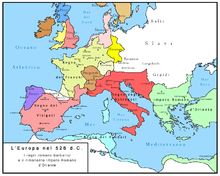Barbarian kingdoms


Barbarian kingdoms is a term for the Germanic kingdoms established on the lands of the Western Roman Empire during Late Antiquity. They mark the transition from Late Antiquity to the Early Middle Ages in the 6th and 7th centuries, gradually replacing the Roman system of government in the two western prefectures of Gaul and Italy.[2]
The most important and most successful of these kingdoms was that of the Franks. Established in the 4th to 5th century, the Frankish kingdom grew to include much of Western Europe, developing into the early medieval Carolingian Empire and ultimately the kingdom of France and the Holy Roman Empire of the high medieval period. The kingdoms of the Visigoths and Ostrogoths were established in the 5th century; the Ostrogothic kingdom was re-conquered by the Eastern Roman Empire in the 550s, while the Visigothic kingdom survived into the 8th century, and finally fell to the Muslim invasion of Spain. The Lombardic kingdom in Italy was established in the 6th century and conquered by the Franks in 774. The Vandal Kingdom existed in Africa and Sicily during 435–534. The kingdoms of the Burgundians and of the Suebi were established in the early 5th century, and fell to the Franks and the Visigoths, respectively, in the 6th century.
These kingdoms were foederati of the Roman Empire, and even after the fall of the Western Roman Empire in AD 476 they continued to at least nominally consider themselves subject to the Eastern Emperor. These historical ties with the empire were weakened in the later 6th century, with the loss of much of the western possessions of the empire under Justin II and the waning power projection by the empire, weakened by its wars with the Persians and the Arab invasion.
As a result the "barbarian kingdoms" by the 7th to 8th centuries developed the system of feudalism characteristic of the European Middle Ages. The title of "emperor" was revived in the west by Charlemagne in AD 800. At the same time, the Carolingian Renaissance developed the notion of Europe as a geopolitical entity with a history separate from that of the wider Mediterranean region.
See also
- Early Middle Ages
- Byzantine Empire under the Justinian dynasty
- History of Europe
- Migration Period
- Dark Ages (historiography)
- Core Europe
- Germanic Europe
- Latin Church
- Germanic Christianity
- Germanic Heroic Age
- Romano-Germanic culture
- Timeline of Germanic kingdoms in the Iberian Peninsula
References
- ↑ Michael Frassetto, The Early Medieval World: From the Fall of Rome to the Time of Charlemagne vol. 1 "Coins and Coinage", p. 203.
- ↑ Kidner et al. (eds.), Making Europe: People, Politics, and Culture vol. 1 (2009), 198–203. J. Herrmann, E.- Zürcher (eds.), History of Humanity: From the seventh century B.C. to the seventh century A.D., UNESCO (1996), p. 255.
- Walter Pohl (ed.), Kingdoms of the Empire: The Integration of Barbarians in Late Antiquity, BRILL (1997).
- Michael Frassetto, Encyclopedia of Barbarian Europe: Society in Transformation, ABC-CLIO (2003).
- Thomas F. X. Noble (ed.), From Roman Provinces to Medieval Kingdoms, Routledge (2006)
- Danuta Shanzer (ed.), Romans, Barbarians, and the Transformation of the Roman World: Cultural Interaction and the Creation of Identity in Late Antiquity, Routledge, (2016).
- Guy Halsall, Warfare and Society in the Barbarian West 450-900, Routledge (2008).
- Robert A. Markus "From Rome to the Barbarian Kingdoms (330–700)" in: John McManners (ed.), The Oxford Illustrated History of Christianity, OUP (2001), Oxford, 62–91.
- David Rollason, Early Medieval Europe 300-1050: The Birth of Western Society, Routledge (2014).
External links
- Mike Markowitz, Ancient Coins: Coinage of the Barbarian Invaders, CoinWeek (8 September 2014)